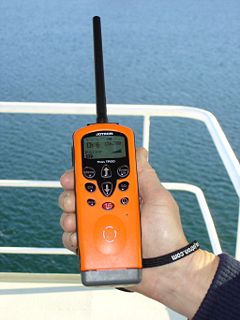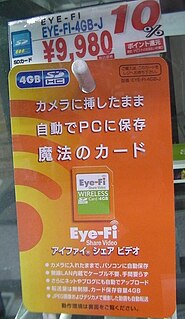
A wireless network is a computer network that uses wireless data connections between network nodes.

Wireless communication, or sometimes simply wireless, is the transfer of information or power between two or more points that are not connected by an electrical conductor. The most common wireless technologies use radio waves. With radio waves distances can be short, such as a few meters for Bluetooth or as far as millions of kilometers for deep-space radio communications. It encompasses various types of fixed, mobile, and portable applications, including two-way radios, cellular telephones, personal digital assistants (PDAs), and wireless networking. Other examples of applications of radio wireless technology include GPS units, garage door openers, wireless computer mice, keyboards and headsets, headphones, radio receivers, satellite television, broadcast television and cordless telephones. Somewhat less common methods of achieving wireless communications include the use of other electromagnetic wireless technologies, such as light, magnetic, or electric fields or the use of sound.

In computer networking, a wireless access point (WAP), or more generally just access point (AP), is a networking hardware device that allows other Wi-Fi devices to connect to a wired network. The AP usually connects to a router as a standalone device, but it can also be an integral component of the router itself. An AP is differentiated from a hotspot, which is the physical location where Wi-Fi access to a WLAN is available.
War dialing or wardialing, a.k.a. "janning", is a technique to automatically scan a list of telephone numbers, usually dialing every number in a local area code to search for modems, computers, bulletin board systems and fax machines. Hackers use the resulting lists for various purposes: hobbyists for exploration, and crackers – malicious hackers who specialize in breaching computer security – for guessing user accounts, or locating modems that might provide an entry-point into computer or other electronic systems. It may also be used by security personnel, for example, to detect unauthorized devices, such as modems or faxes, on a company's telephone network.

Wardriving is the act of searching for Wi-Fi wireless networks by a person usually in a moving vehicle, using a laptop or smartphone. Software for wardriving is freely available on the Internet.

Wi-Fi Protected Access (WPA), Wi-Fi Protected Access II (WPA2), and Wi-Fi Protected Access 3 (WPA3) are three security protocols and security certification programs developed by the Wi-Fi Alliance to secure wireless computer networks. The Alliance defined these in response to serious weaknesses researchers had found in the previous system, Wired Equivalent Privacy (WEP).

WiMAX is a family of wireless broadband communication standards based on the IEEE 802.16 set of standards, which provide multiple physical layer (PHY) and Media Access Control (MAC) options.

A hotspot is a physical location where people may obtain Internet access, typically using Wi-Fi technology, via a wireless local area network (WLAN) using a router connected to an internet service provider.

RailTel Corporation of India Ltd. is a "Miniratna" enterprise of Government of India focusing on providing broadband and VPN services. RailTel was formed in September 2000 with the objective of creating nationwide broadband, telecom and multimedia network, to modernise train control operation and safety system of Indian Railways. RailTel's network passes through around 5,000 stations across the country, covering all major commercial centres.

Google WiFi is a municipal wireless network deployed in Mountain View, California. It is entirely funded by Google and installed primarily on Mountain View lightposts. Google had committed to keeping the service free until 2010. The initial service was shut down by Google on May 3, 2014 at their Mountain View base, and provided a new public outdoor WiFi.

Municipal wireless network is a citywide wireless network. This usually works by providing municipal broadband via Wi-Fi to large parts or all of a municipal area by deploying a wireless mesh network. The typical deployment design uses hundreds of wireless access points deployed outdoors, often on poles. The operator of the network acts as a wireless internet service provider.

Generic Access Network (GAN) extends mobile voice, data and multimedia applications over IP networks. Unlicensed Mobile Access (UMA) is the commercial name used by mobile carriers for external IP access into their core networks. The latest generation system is named Wi-Fi Calling or VoWiFi by a number of handset manufacturers, including Apple and Samsung, a move that is being mirrored by carriers like T-Mobile US and Vodafone.
Piggybacking on Internet access is the practice of establishing a wireless Internet connection by using another subscriber's wireless Internet access service without the subscriber's explicit permission or knowledge. It is a legally and ethically controversial practice, with laws that vary by jurisdiction around the world. While completely outlawed or regulated in some places, it is permitted in others.

Boingo Wireless is an American company that provides mobile Internet access for wireless-enabled consumer devices. The company reports having over one million small cell networks for cellular extension services and Wi-Fi access that reaches more than one billion consumers annually. The company is headquartered in Los Angeles, California.

Eye-Fi was a company based in Mountain View, California that produced SD memory cards and SDHC cards with Wi-Fi capabilities. Using an Eye-Fi card inside a digital camera, one could wirelessly and automatically upload digital photos to a local computer or a mobile device such as a smartphone or tablet.
Wi-Fi Direct, initially called Wi-Fi P2P, is a Wi-Fi standard enabling devices to easily connect with each other without requiring a wireless access point. Wi-Fi Direct allows two devices to establish a direct Wi-Fi connection without requiring a wireless router. Hence, Wi-Fi Direct is single radio hop communication, not multihop wireless communication, unlike wireless ad hoc networks and mobile ad hoc networks. Wi-Fi ad hoc mode, however, supports multi-hop radio communications, with intermediate Wi-Fi nodes as packet relays.

BT Wi-fi is a global wi-fi hotspot service provided by United Kingdom telecommunications company BT Group in partnership with Fon. It was established following a rebranding of the former BT Openzone and BT Fon, bringing both of the services under one name. It supports the BT Consumer division, providing free, unlimited BT Wi-fi for current broadband and mobile customers. It is the worlds largest wi-fi network with more than 5 million hotspots in the UK and another 9 million around the world. It can be accessed in a variety of places such as cafés, pubs, airports, hotels, motorway service stations, city centres and a range of independent businesses who have partnered up to provide its service.
Google Fi is an MVNO telecommunications service by Google that provides telephone calls, SMS, and mobile broadband using cellular networks and Wi-Fi. Google Fi uses networks operated by Sprint, T-Mobile, U.S. Cellular, and Three.
Google Station is a Google service that allows partners to roll out Wi-Fi hotspots in public places by providing software and advice on hardware to turn fiber connections into Wi-Fi. It was only implemented in India and Indonesia but in March 2018, the service was launched in Mexico too, and the company plans on rolling it out in other countries as well.


















